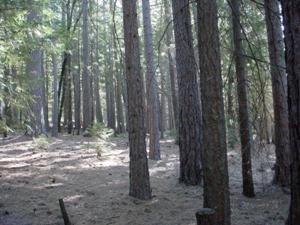Return to Boggs Mountain A-Meet
Spring Lake Regional Park and
Boggs Mountain State Demonstration Forest
Featuring the 2009 U.S. Team Trials
Date: May. 1 - 3, 2009
Location: Santa Rosa, CA & Cobb, CA
Event Directors: - 510.681.6181, - 415.456.8118
Course Setters: Mikkel Conradi, Evan Custer, George Minarik
Type: A; 3-day A-meet, featuring the 2009 U.S. Team Trials and 2 WRE days; recreational courses Saturday & Sunday for non-competitors
Course Setter's Notes – Friday Sprint Courses
By
Preliminary Course Statistics
Course Competitors Length Climb Controls
Sprint 1 White/Yellow 2.1 km 40 m 9 Sprint 2 Orange/Brown/Green/Red 2.5 km 75 m 12 Sprint 3 Blue 2.9 km 85 m 14
Start & Finish
The start is 1.3 km from the parking area. Please budget for a 10-minute jog or 20-minute walk to get there. The Finish is 100 m from the parking lot, and it will be possible to cheer on the finishers.
Note for Team Trialers: Remember that your assigned start time cannot be changed. If you are late, you can either (a) start right away, but keep your original assigned start time, or (b) ask for a new start time, but then you will not be eligible for the Team Trials.
Control descriptions will be handed out at the Start, after the Call-up line. There will also be control descriptions on the maps. No control descriptions will given out in the packets.
Clothing left at the Start will be returned to the assembly area.
Map
The Spring Lake map originally was attached to a larger map of Annadel State Park. The original map was created in 1988-89 by Ivar Helgesen and Rami Pitkanen, and it was revised in 1996-97 by George Kirkov.
For the 2009 Team Trials Sprint, Bob Cooley has converted the Spring Lake portion of the map to ISSOM (International Standard for Sprint Orienteering Maps) symbols, and made over one thousand corrections.
There are three notable departures from the ISSOM standard:
- The contour interval is 5 m, even though the scale is 1:5000. (There is quite generous use of form lines.)
- Most of the permanent benches and tables are mapped.
- The park is not closed to traffic during the event.
We expect traffic to be light on a Friday, but we have no authority to stop vehicles driving around the park. All the courses will cross a road that leads to a boat launch, and there are also picnic areas and campgrounds that have vehicle access. We will put up a Runners in Road sign, but there will be no crossing guard, and runners should be aware that drivers might not stop. Team Trial runners who feel that their result was impacted by traffic will need to bring this up with the U.S. Team Trial officials.
The courses have been designed to utilize the most runnable terrain in the park, including grassy fields, runnable forest, dirt trails, and paved trails. The terrain is generally rocky, and there is a fair amount of stony ground. Some of these stones are large, flat slabs that are quite runnable, although you have to watch your footing when stepping on and off the edge. There's also a fair number of stony pits, some of which are shallow and some of which are quite deep.
Several areas where the stone slabs are close together have been mapped as "bare rock". Note that unlike the typical pine forest "bare rock", these areas have poor runnability and pose a risk of ankle injuries if attempting them at high speeds. No leg has been designed for the fastest route to go across areas mapped as bare rock.
The map has a variety of vegetation types. The grasses and wildflowers have grown quite tall in some of the fields, and they might not be as runnable as one would normally expect. The white forest is quite runnable, except for the rocky features previously mentioned. There's not a lot of vegetation mapped as green, but there is some manzanita in spots, and various scrubs and thickets. Anything mapped as dark green is best avoided. Some fields have scattered scrubs that are not mapped.
Most man-made objects are either permanent park benches or tables that are chained down. The campground has tables with a bear box attached to one end, but there are also tables without these boxes. Large, permanently installed work-out stations are mapped, and so are several map boards.
Note that the IOF/USOF standards allow for controls on different features as close as 30 m apart, and on similar features as close as 100 m apart.
Hazards
The primary hazards on this map are:
- Uneven footing.
- Vehicles.
- Other competitors and park guests.
- Ticks.
I have not noticed much poison oak on the map, but I wouldn't doubt that there is some hiding out there.

